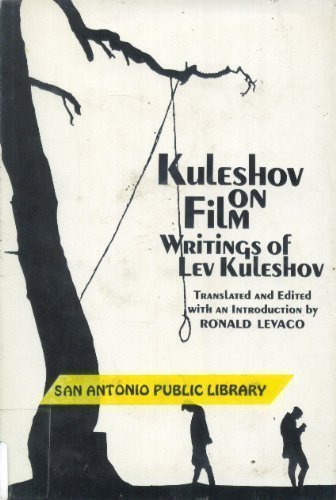Kuleshov on Film: Writings by Lev Kuleshov book
Par moses michael le lundi, février 1 2016, 22:51 - Lien permanent
Kuleshov on Film: Writings by Lev Kuleshov. Lev Vladimirovich Kuleshov, Ronald Levaco

Kuleshov.on.Film.Writings.by.Lev.Kuleshov.pdf
ISBN: 0520026594,9780520026599 | 121 pages | 4 Mb

Kuleshov on Film: Writings by Lev Kuleshov Lev Vladimirovich Kuleshov, Ronald Levaco
Publisher: Univ of California Pr
If you already read my thoughts about this film on IMDb, there's no need to read this, since it's basically the same stuff I already said there (albeit with spoiler stuff). The Great Consoler is Lev Kuleshov's most personal film reflecting both the facts of his life and his thoughts about the place of the artist in contemporary reality. Soviet film makers of the 1920s like Kuleshov, Pudovkin, and Sergei Eisenstein all were founding fathers of montage, although it is argued that Eisenstein defined. Concerning emotional resonance in cinema the Kuleshov Effect is an important concept. Ray Zone Research Provocation, A Spatial Web: The third dimension in Lev Kuleshov's theory of montage. In 1918, a Russian filmmaker called Lev Kuleshov conducted an experiment where he shot and edited a short film in which the face of a famous Russian matinee idol was intercut with three other shots: a plate of soup; a girl playing ball; an old process into one category, but without understanding the first 6 steps of this formula, you are setting yourself up for “filmmaker mediocrity” – which is writing unimaginative scripts with unbelievable characters that create boring and dull films. Although Lev Kuleshov was the first to experiment with Montage, Eisenstein argued that the collision between two adjoining images creates a third meaning. Lev Vladimirovich Kuleshov was a scientist and founder of the Moscow School of Cinema in 1919, the world's oldest film school. Griffith, Kuleshov created a conceptual inventory of artistic effects possible for cinematography and in his writing he makes repeated references to the depiction of objective reality and spatial representation. By the Law (Lev Kuleshov, 1926). Kuleshov and the Juxtaposition of Shots. The Kuleshov effect is a film editing technique that was recognised and demonstrated by Russian filmmaker Lev Kuleshov between 1910-1920 during his montage experiments. Russian cinema came of age with the 1917 revolution. It rests on the theory of montage and the effect that film editing has on evoking emotions from a viewer. If I can make one conclusion from the two films I've seen of Lev Kuleshov, it's that he isn't the least bit afraid to wear the influence of America on his sleeve. So basically the Kuleshov effect is a cinematic editing technique that was developed by this Russian bloke Lev Kuleshov in the early 20th century. '…the work of the film actor must be constructed with the After viewing the films of D.W. He said editing should make people think, not just see what they see. These three films and four others are showing at Facets Cinematheque this week, along with a film Barnet acted in (Lev Kuleshov's 1924 knockabout farce The Extraordinary Adventures of Mr.